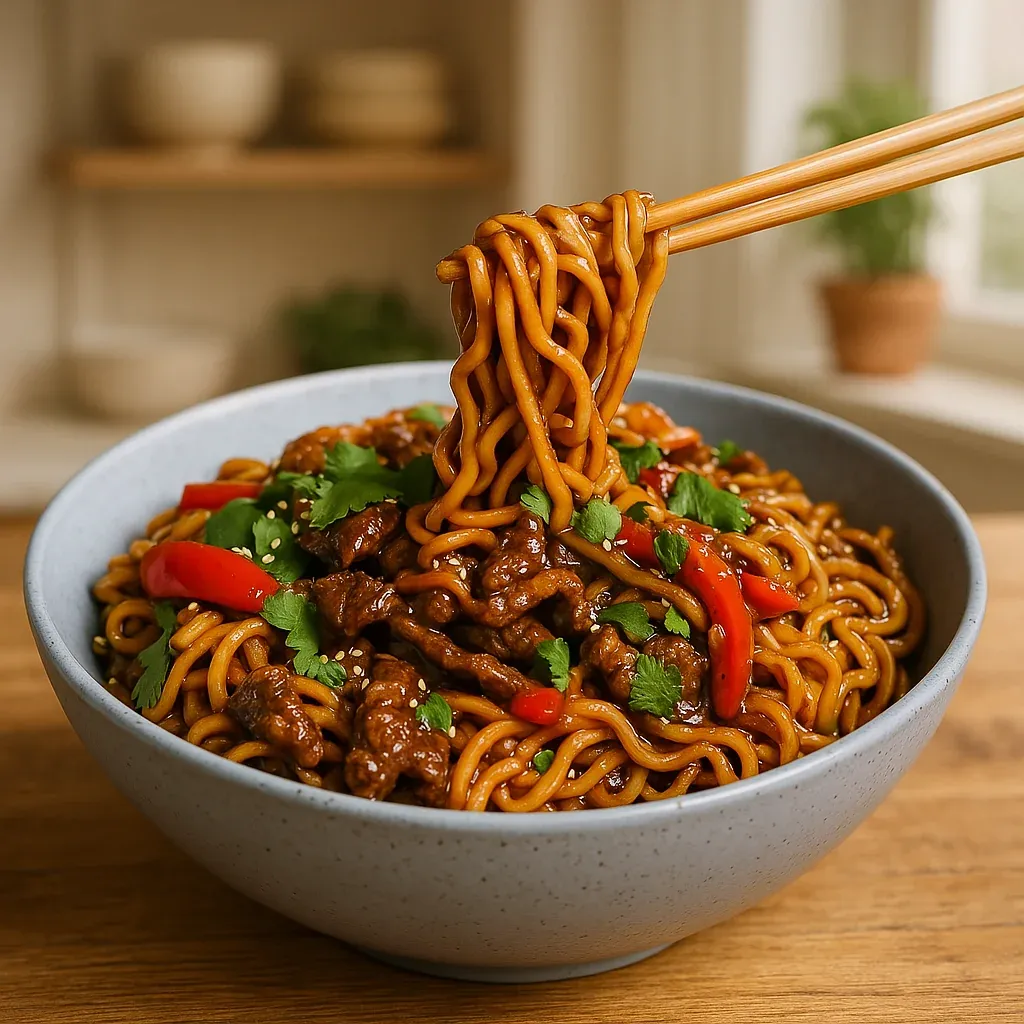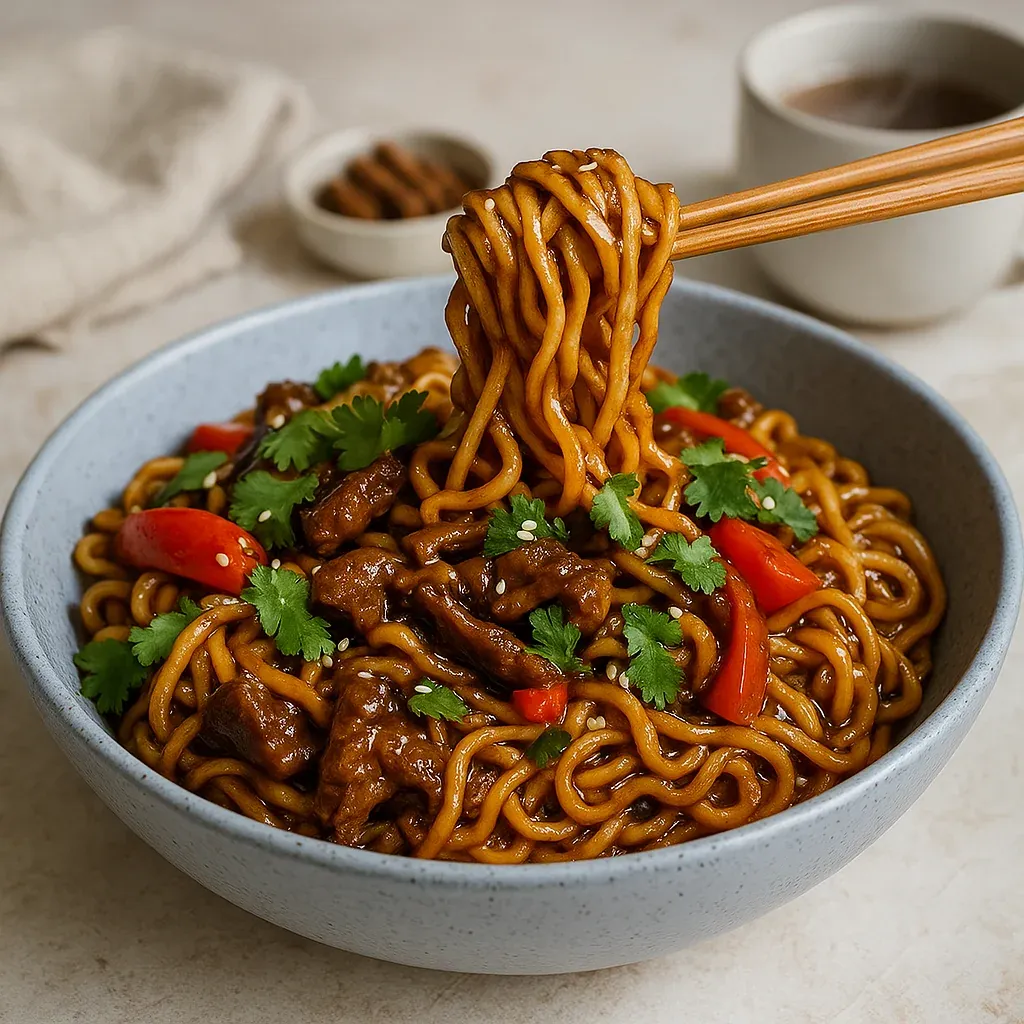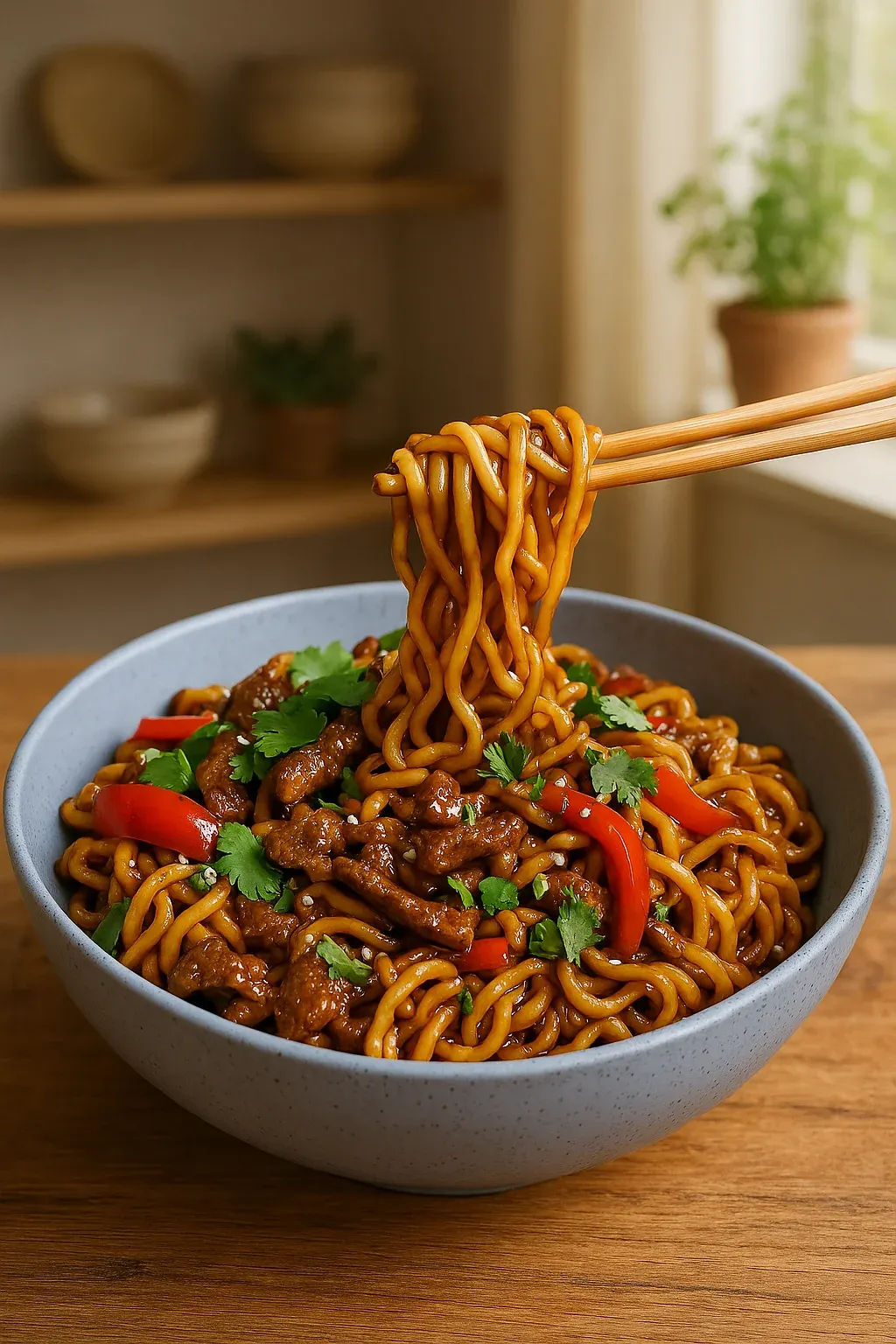 Pin it
Pin it
This hearty hoisin beef noodle dish has been my weeknight savior for years, combining the perfect balance of sweet, savory and umami flavors in under 30 minutes.
I first created this recipe during a particularly hectic week when I needed something fast yet satisfying. What began as a quick pantry dinner has since become my most requested meal when friends come over for casual gatherings.
- Beef: 500g thinly sliced sirloin or flank steak. The thin slicing is crucial for quick cooking and tender results.
- Noodles: 400g rice or egg noodles. The wider varieties catch more of the delicious sauce.
- Hoisin Sauce: 4 tablespoons. This is our flavor foundation, look for one without artificial colors.
- Soy Sauce: 2 tablespoons. Adds depth and saltiness, use low sodium if watching salt intake.
- Garlic: 3 cloves minced. Fresh is non-negotiable here for the best aromatic base.
- Ginger: 1 tablespoon freshly grated. The warmth it adds cannot be replicated by powder.
- Vegetable Oil: 2 tablespoons for stir frying. Use something with a high smoke point.
- Green Onions: 4 stalks chopped. The white parts cook with the dish, greens for garnish.
- Bell Peppers: 1 red thinly sliced. Adds sweetness and beautiful color contrast.
- Carrots: 1 large julienned. The slight crunch provides textural balance.
- Sesame Seeds: 1 tablespoon for garnish. Toast them first for maximum flavor.
Step-by-Step Instructions
- Prepare Meat and Marinade:
- Slice beef against the grain into very thin strips no thicker than 1/4 inch. In a bowl, whisk together hoisin sauce, soy sauce, half the minced garlic, and half the grated ginger. Add beef strips to this mixture, ensuring each piece gets coated evenly. Allow to marinate for at least 15 minutes while you prepare other ingredients. The marinade begins tenderizing immediately, creating melt in your mouth beef.
- Cook the Noodles:
- Bring a large pot of water to a rolling boil. Add noodles and cook exactly according to package directions. For rice noodles, this is typically just 3 to 4 minutes. Test frequently by taking a strand and biting through it. The noodle should be tender but still have slight resistance. Immediately drain and rinse under cold water to stop the cooking process. Toss with a few drops of oil to prevent sticking while you finish the other components.
- Stir Fry Vegetables:
- Heat a wok or large skillet until you can feel heat radiating when you hold your hand above it. Add 1 tablespoon oil and swirl to coat the surface. Add remaining garlic and ginger, stirring rapidly for just 30 seconds until fragrant but not browned. Add carrots first, stir frying for 2 minutes before adding bell peppers. Keep everything moving constantly with a wooden spatula or tongs. Cook until vegetables are vibrant in color and slightly softened but still crisp, about 3 minutes total.
- Cook the Beef:
- Push vegetables to one side of the pan and add remaining tablespoon of oil to the empty space. Add marinated beef in a single layer, leaving behind excess marinade for now. Let beef sear undisturbed for 1 minute before stirring. Cook just until beef changes color on all sides, about 2 minutes total. Overcooking will make the beef tough, so err on the side of slightly undercooked as it will continue cooking with the noodles.
- Combine Everything:
- Add the cooked noodles to the pan along with any reserved marinade. Use tongs to toss everything together, ensuring noodles get evenly coated with sauce. Add half the green onions and continue stir frying for 2 minutes until everything is well combined and heated through. If the mixture seems dry, add 1 to 2 tablespoons of water to create more sauce.
 Pin it
Pin it
The hoisin sauce is truly the star ingredient here. I discovered its versatility years ago when experimenting with Asian flavors, and now keep multiple jars in my pantry. My daughter actually calls this "magic sauce noodles" because she claims the hoisin transforms everything it touches into something irresistible.
Storage and Leftovers
This dish shines even brighter the next day after the flavors have had time to meld together. Store leftovers in an airtight container in the refrigerator for up to 3 days. When reheating, add a splash of water to loosen the sauce as the noodles will have absorbed much of it overnight. I prefer reheating in a skillet rather than microwave to maintain the texture of the vegetables and beef.
For longer storage, you can freeze portions for up to 2 months. Thaw overnight in the refrigerator before reheating. The texture of the noodles may change slightly, but the flavor remains fantastic.
 Pin it
Pin it
Making It Your Own
While the classic version of this recipe is delicious as written, there are endless ways to personalize it. For a spicier version, add a tablespoon of sriracha or chili oil to the marinade. Vegetarians can substitute the beef with firm tofu, pressed and sliced, or meaty mushrooms like portobello or king oyster.
The vegetable components are flexible based on what you have available. Snow peas, broccoli florets, bean sprouts, or bok choy all work wonderfully. Just remember to add harder vegetables first and more delicate ones toward the end of cooking.
For a low carb option, substitute the noodles with spiralized zucchini or another vegetable noodle. The sauce works beautifully with these alternatives, though cooking time will be significantly reduced.
Serving Suggestions
Hoisin beef noodles can stand alone as a complete meal, but for special occasions, consider adding some complementary sides. A simple cucumber salad dressed with rice vinegar and sesame oil provides a cooling contrast to the rich noodles. Steamed dumplings or spring rolls make excellent appetizers that continue the Asian flavor theme.
For beverages, jasmine tea or a crisp Asian lager pairs wonderfully with the sweet and savory notes of the dish. If serving wine, opt for a slightly sweet Riesling or Gewürztraminer that can stand up to the bold hoisin flavors.
Frequently Asked Questions
- → What is hoisin sauce, and what does it taste like?
Hoisin sauce is a thick, fragrant sauce used in Chinese cuisine. It has a rich, slightly sweet, and tangy flavor with hints of soy, garlic, and spices.
- → Can I substitute the beef in this dish?
Yes, you can substitute beef with chicken, pork, tofu, or even plant-based options like tempeh or seitan for a vegetarian version.
- → What noodles work best for this dish?
Rice noodles or egg noodles are ideal, but you can also use soba, udon, or zucchini noodles for variations.
- → How do I prevent overcooking the noodles?
Follow the package instructions for cooking time and rinse noodles under cold water after boiling to stop them from overcooking.
- → What vegetables can I add or substitute?
Popular options include broccoli, mushrooms, spinach, or snow peas. Feel free to use vegetables you have on hand for flexibility.
- → How do I store and reheat leftovers?
Store leftovers in an airtight container in the fridge. Reheat in a skillet with a splash of water or broth to loosen the noodles and refresh flavors.
